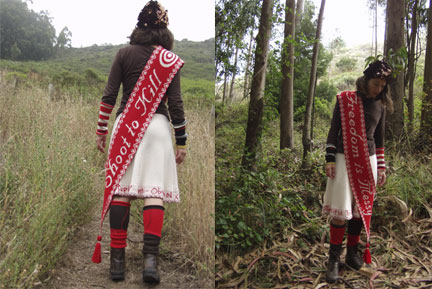
Galen is reading Taking Charge of Your Fertility. Partway through a chapter, he popped in to do a dance of excitement about how interesting he is finding fertility awareness. Ovaries! Mucus! Feedback cycles! DIY science! He asked whether it would have been cool to learn about cycle charting when I was thirteen or so, so I could have had a lifetime archive of data about my reproductive health. Wow, that caused a lot of feelings at once.
First, go team! It is useful and friendly for bio-guys to learn about female physiology, reproductive health, menstrual cycles and all that. I still tell people gleefully about the time last year that (male) Galen and our (male) friend Nathan were discussing their favourite features of the diva cup. (“Well it has marks so you can measure your blood.”) Doing their part to make the world safe for menstruators.
But also, awww, yes I do wish I’d known interesting ways to chart when I was starting out, or had any decent period information. It is amazing to me that after a solid eight or nine years of purposely investigating menstruation and cultivating positive attitudes and general insatiable curiosity, I still get ambushed by leftover sad feelings around menstrual cycles.
I don’t seem to have had an especially negative or ignorant upbringing compared to other people I know, but I managed to accumulate a fair amount of emotional trauma about periods just through a general lack of self-determination as a teenager. Dumb everyday stuff, like I was neither in charge of buying my own underwear nor in charge of how the laundry got done when I lived with my parents, so I was constantly frustrated and embarrassed (and often getting yelled at) about dealing with period laundry. It seems like surely I could have been responsible for either or both of those things if it had occurred to me— I don’t think my parents were that authoritarian— but strangely I remember arguing about wanting to do my own laundry my own way and being unable to work out any arrangement. Even now, I often find simple plans impossible to coordinate with my parents, for reasons I can rarely even remember. It’s deeply confusing. I think part of my lingering upset about menstrual cycles is actually due to the fact that I can’t recall any coherent explanations for past conflicts on the subject. Hmm.
Galen knows all this, at least superficially. I talk about vagina-related feelings with pretty much anyone who’s up for it. The most recent neighbourhood rock club was on the theme of songs to change your past and I picked a song that might have prevented me from going on the pill if I’d heard it while I was resigning myself to modern living through pharmacology. (In The Evening by Nina Nastasia and Jim White, because it makes me feel stubborn and that’s what I needed to be.)
I am sad that I ate all those chemicals, and that it seems to have done some damage to my cervical crypts (where the infamous eggwhite fertile mucus is produced). Sad sad sad. Angry too, to feel so misinformed. Disappointed that I didn’t listen to my own better judgment, and betrayed on behalf of the part of me with better judgment. I said most of that at rock club, but I’m not sure that is something people can relate to without a fair amount of relevant experience or other knowledge. Erin afterwards said she had a grieving process about the pill. Me too, going on it and again going off.
So Galen’s latest round of excitement about menstrual cycles is complicated. I was immediately glad to have company, and also immediately lonely, realizing I’m cut off from the possibility of feeling simple, impersonal excitement about uteruses and their ways. It was good to realize that he’s in the rather privileged position of not having personal emotional baggage about menstrual cycles. Once I managed to make him all sad about my damaged cervical crypts and assorted teen angst, we had a better connection there. It’s good to be on the same team.
So. For my future babies, I keep track of books like Cycle Savvy, in case they don’t want to talk with me about their personal strategies and feelings about periods.







